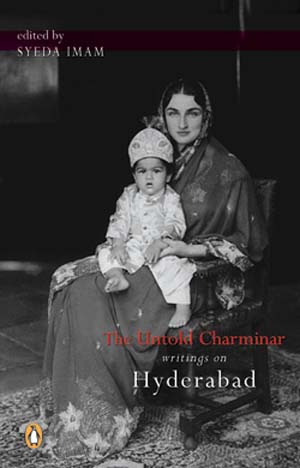Dec 30, 2025
Dec 30, 2025
 Edited by former "ad-woman" Syeda Imam, "The Untold Charminar: Writings on Hyderabad" is an anthology on a city that was once ruled by the world's richest man - the Nizam. And its essays sure shine like the twinkling jewels in his treasury.
Edited by former "ad-woman" Syeda Imam, "The Untold Charminar: Writings on Hyderabad" is an anthology on a city that was once ruled by the world's richest man - the Nizam. And its essays sure shine like the twinkling jewels in his treasury.
Hyderabad after all bequeathed to the world some of the most legendary diamonds that the Indian royalty has ever seen - the Orloff, the Jacob, the Hope, the Great Moghul, the Taj-e-Mah and the Darya-i-Noor, mined from the famous pits of Golconda.
The anthology narrates the evolution of Hyderabad as a niche technology and heritage hot spot from an ancient fort city 500 years ago through 38 essays penned by William Dalrymple, Nawab Sir Mahdi Yar Jung Bahadur, Sarojini Naidu, Shyam Benegal, Mark Tully, Anees Jung, Nagesh Kuknoor and several other big names in the spheres of art, culture and literature.
The story of Hyderabad began in 1580-1611 when Muhammed Quli Qutb Shah, the fifth and the most celebrated ruler of the Qutb Shahi dynasty of Golconda, issued a decree that a new city be built outside the fort.
The day was auspicious, according to Ferishta, "when the moon was in the constellation of Leo and Jupiter was in its own mansion".
The ancient fort city of Golconda then flourished under the Shah dynasty till the Mughal emperor Aurangzeb came to its gates with a huge army and vanquished the sultan. The city fell. The new Hyderabad came up on the ruins of what was once described as the most liberal and well-planned cities in Muslim India of the 16th century.
Hyderabad, as editor Syeda Imam says, has three distinct identities - the ancient, modern and the contemporary. It is also the cyber city of former chief minister N. Chandrababu Naidu's dreams where the Indian arms of the blue chip global infotech giants jostle for space with old crumbling Muslim mansions, an indigenous Dakhini culture laden with influences of Islam, Sufism and local Telugu traditions, and mouth-watering Nizami cuisine.
The oddity about Hyderabad, Imam writes in her introduction, perhaps is that it does not have a staid core. It strides anew from time to time without losing itself. This may take a while for the reader to discover - but the gradual process of uncovering the layers of a city replete with diverse nuances and a medley of cultural influences make the book worth reading.
If the first chapter, "Hyderabad through Foreign Eyes" by Narendra Luther delves into the makings of ancient Golconda, the parent city, through the eyes of travellers who drifted into the city with the surge from the west, east and north in its early days.
The second chapter, "Sunset over Golconda", carries it forward to how the city came to its logical end - a crushing defeat at the hands of emperor Aurangzeb.
The next chapter tells the story of Chanda Bai, a famous courtesan of Golconda, who fought on the frontlines and was conferred the title of Mahlaqa. It probes her life - which is a saga of colours, courage and social spice that sheds light on the status of women in ancient Golconda that outshone those of men in tales of feminine exploits, valour on battlefield and unconventional ways.
The convocation address delivered by Nawab Sir Mehdi Yar Jung Bahadur at Osmania University in December 1941 and reproduced in entirety is a window to the Hyderabdi academia that enriched itself through exchange with Europe and the neighbouring states.
Isac Sequira describes a traditional "mehfil" (assembly of Urdu poets) with snatches of their poetry in "The Mystique of the Mushaira" while a literary missive by the city's brave daughter Sarojini Chatterjee nee Naidu, "Letters Too Tell Stories", is an poetic ode to her foster home - the city that saw the spirited poet-politician rise to glorious heights.
Rich, anecdotal, this book is full of personal touches that give a global view of the city.
The compilation makes one important statement that a city as diverse and gentrified as Hyderabad or for that matter any other heritage metropolis of India can best be described to a global audience through the eyes of many - and not just one.
The fact that so many doyens from such a wide spectrum of the country's artistic mosaic have put their thoughts together to describe a single subject - a city as richly nuanced as Hyderabad - does justice to its diverse spirit. Capturing Hyderabad in print is definitely beyond one man's penmanship.
26-Jul-2008
More by : Madhusree Chatterjee

|
its very nice information ..........thax |